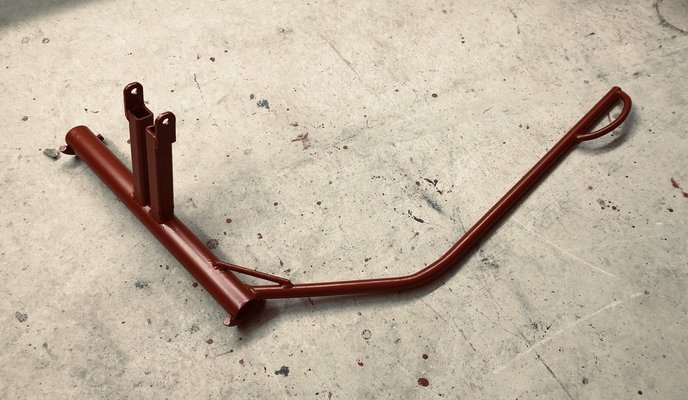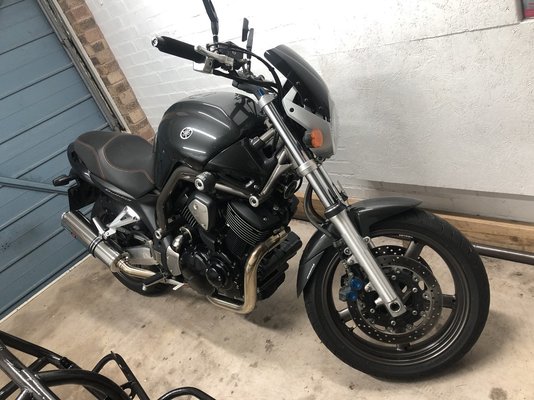Sergei Slovenija
Member
- Messages
- 1,267
- Location
- Slovenija Ljubljana
First ship
First ship
Bit extra to help the gasket seal, hour of back and forth and hands impregnated with aluminium splinters.
I need a fly cutter.
View attachment 439079
I've only got a little Clarke cmd10 mill lol, sadly uses mt2 so that wouldn't fit.I'd recommend one of these. Its not an adjustable fly cutter but it does work well atleast for my lathe. Amazing the speed it will turn a piece to chips.
The inserts comes with are not ideal I generally use the much sharper type
I use them on steel but its expected that will chip them sooner - I get a reasonable life out of them.


great work, looking forward to the device in actionI wanted to dedicate yet another TIG torch for use with my cold wire feeder. This torch would be set up with stubby gas lenses.
Instead of spending the cash for a factory mounting bracket and wire guide, I thought I would have some fun in the shop by making my own mounting bracket and wire guide. This particular mounting bracket would attach to the torch body (handle) instead of the torch head. To make the mounting bracket, I cut off a chunk of ½” mild steel, bored the large hole (to fit the torch handle) with my lathe, shaped the outer contour by hand on my 12” disc sander, drilled a 3/8” hole for the wire guide, and then drilled and tapped it for three 1/4-20 set screws. I then bead blasted it and applied gun bluing to finish it.
View attachment 439122
View attachment 439120
View attachment 439121
To make the wire guide, I found a piece of thick-wall brass pipe, which I threaded a little over half its length on the lathe (3/8-24 thread), and soldered on a threaded stop ring made by cutting a slice from a brass pipe fitting.
View attachment 439124
Then I found some stiff, thick-wall copper tubing (3/16” OD), countersunk one end of the copper tube to mate with the tapered end of the wire feed cable sheath that slides into the brass pipe, bent and trimmed the copper tube to fit, and soldered it into the brass pipe. I threaded the end of the copper tube (10-32 thread) to accept a CK wire feed tip, sized to match the welding wire size. The wire guide is positioned/secured with a jam nut and a spring, so that I can pivot the wire guide out of the way without loosening any jam nuts. If it turns out that the spring isn’t stiff enough to keep the wire guide from moving while in use, I can either find a stiffer spring or go with a pair of jam nuts.
View attachment 439126
View attachment 439125
I don’t think the extra torch weight from the steel mounting bracket and other parts will bother me. In fact, I suspect that the added mass might add a bit of stability by damping some of my shakiness. Maybe I would think differently about that if I were doing production work, but I’m only doing hobby/one-off stuff, so I’m not holding the torch for extended periods.
Now I need to experiment with the welder and cold wire feeder and try to come up with some useful setting combinations that will work for some of the typical welding scenarios that I encounter.
Disclaimer: I'm just an amateur welder, and I do not warrant the safety, functionality, or applicability of any of my ideas displayed or described here.

We should have a whip round and buy you a mug welder, Blue Chips.The next step in getting my recently-purchased TIG cold wire feeder up and running was to make a pair of torch-mounted switches (or 'triggers' if you prefer) for the TIG welder and wire feeder. This is experimental (at least for me). Instead of using a single SPST switch as found on many TIG torches, I decided to make a double switch, consisting of two separate SPST momentary switches mounted side by side to control the TIG welder and wire feeder separately. I picked out a couple of switches with ‘paddle’ action, sort of like a lot of typical TIG triggers.
View attachment 439081
I cut a couple of pieces of frosted polycarbonate to make a bracket for the switches, screwed the switches and bracket together, applied heat-shrink tubing on the connectors and cable (double heat-shrink in places), and put together a “Y” cable with the appropriate Amphenol connectors for the TIG welder and the cold wire feeder.
View attachment 439083
My rationale for the separate switches was to be able to control the welder and wire feeder in a few different ways. I made this little chart showing combinations based on using the torch-mounted switches and a foot pedal as an alternative controller. I also have a torch-mount sliding amperage controller, but I haven’t factored that into the chart yet.
View attachment 439084
I bought a CK wire guide bracket to mount the CK wire guide (which I already had) on the head of one of my TIG torches. The bracket was a bit pricey, but CK stuff is good quality. It's very sturdy and seems to fit my existing torch securely.
View attachment 439085
After mounting the CK bracket and wire guide on the torch, I mounted the switches on the torch body with tie-wraps and added a couple of tie-wraps on the cable for strain relief. If everything works well, I might eventually come up with a more streamlined setup for the torch switches (maybe some off-the-shelf unit?), but this should do for now.
View attachment 439086
View attachment 439087
My next little project is to set up another dedicated wire-feed torch for use with stubby gas lenses.
Disclaimer: I'm just an amateur welder, and I do not warrant the safety, functionality, or applicability of any of my ideas displayed or described here.

I have a couple of MIG welders, and I was recently asked to weld a friend's stainless steel coffee mug, but I don't have a machine specifically designed for welding mugs.We should have a whip round and buy you a mug welder, Blue Chips.


Damned AutoCorrect rather ****es on attempts at humour, doesn't it? Probably about time I educated my AutoCorrect about welding terms.I have a couple of MIG welders, and I was recently asked to weld a friend's stainless steel coffee mug, but I don't have a machine specifically designed for welding mugs.
But if it's a tool that I don't have, I definitely need it!
I figured as much.Damned AutoCorrect rather ****es on attempts at humour, doesn't it? Probably about time I educated my AutoCorrect about welding terms.

I’d never even thought such a thing was possible, but now I see it it looks like a great idea. Is the wire feed electric, and you can vary the speed on the move?I wanted to dedicate yet another TIG torch for use with my cold wire feeder. This torch would be set up with stubby gas lenses.
Instead of spending the cash for a factory mounting bracket and wire guide, I thought I would have some fun in the shop by making my own mounting bracket and wire guide. This particular mounting bracket would attach to the torch body (handle) instead of the torch head. To make the mounting bracket, I cut off a chunk of ½” mild steel, bored the large hole (to fit the torch handle) with my lathe, shaped the outer contour by hand on my 12” disc sander, drilled a 3/8” hole for the wire guide, and then drilled and tapped it for three 1/4-20 set screws. I then bead blasted it and applied gun bluing to finish it.
View attachment 439122
View attachment 439120
View attachment 439121
To make the wire guide, I found a piece of thick-wall brass pipe, which I threaded a little over half its length on the lathe (3/8-24 thread), and soldered on a threaded stop ring made by cutting a slice from a brass pipe fitting.
View attachment 439124
Then I found some stiff, thick-wall copper tubing (3/16” OD), countersunk one end of the copper tube to mate with the tapered end of the wire feed cable sheath that slides into the brass pipe, bent and trimmed the copper tube to fit, and soldered it into the brass pipe. I threaded the end of the copper tube (10-32 thread) to accept a CK wire feed tip, sized to match the welding wire size. The wire guide is positioned/secured with a jam nut and a spring, so that I can pivot the wire guide out of the way without loosening any jam nuts. If it turns out that the spring isn’t stiff enough to keep the wire guide from moving while in use, I can either find a stiffer spring or go with a pair of jam nuts.
View attachment 439126
View attachment 439125
I don’t think the extra torch weight from the steel mounting bracket and other parts will bother me. In fact, I suspect that the added mass might add a bit of stability by damping some of my shakiness. Maybe I would think differently about that if I were doing production work, but I’m only doing hobby/one-off stuff, so I’m not holding the torch for extended periods.
Now I need to experiment with the welder and cold wire feeder and try to come up with some useful setting combinations that will work for some of the typical welding scenarios that I encounter.
Disclaimer: I'm just an amateur welder, and I do not warrant the safety, functionality, or applicability of any of my ideas displayed or described here.
Here's a link to my post about acquiring the wire feeder: https://www.mig-welding.co.uk/forum/threads/today-i-acquired.50192/post-2391402I’d never even thought such a thing was possible, but now I see it it looks like a great idea. Is the wire feed electric, and you can vary the speed on the move?




